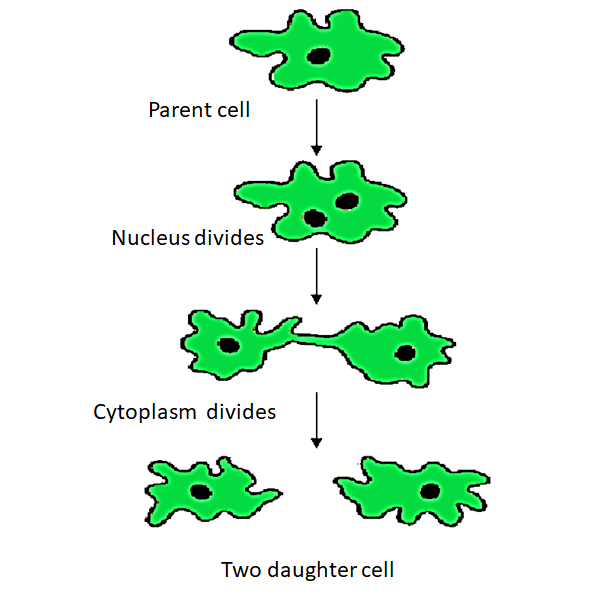
The process of asexual reproduction in amoeba is
(a) Binary fission
(b) Budding
(c) Vegetative reproduction
(d) Spore formation
Answer
497.4k+ views
Hint:Amoeba divides into two halves to form two daughter cells. In the process of asexual reproduction through which amoeba reproduces parent itself is a reproductive unit and continues to live as two daughter individuals.
Complete answer:
Amoeba reproduces asexually by the process called binary fission. Binary fission occurs in single- celled organisms belonging to Kingdom Monera, and Protista (Amoeba and paramecium). In this process, the parent organism divides into two halves, each half forming an independent daughter organism. It means the parent body as a whole form the reproductive unit, and the parent continues living as two daughter individuals.
Depending on the plane of division, binary fission is of the following types: Simple binary fission: Also known as irregular binary fission. A division can occur through any plane. For example Amoeba. Longitudinal Binary Fission: The plane of division passes along the longitudinal axis of the organism. Example, Euglena Transverse Binary division: The plane of this division runs along the transverse axis of the individual, for example, Bacteria, Paramoecium, Diatoms.

So, the answer is, ‘Binary fission’.
Note: - In binary fission cell division itself is a mode of reproduction. - It involves amitosis in bacteria and mitotic division of the nucleus in yeast and amoeba i.e.,
karyokinesis (a division of the cytoplasm) followed by cytokinesis (a division of the nucleus). - The parent cell in binary fission disappears. - Protuberance like in budding is absent in binary fission. - There is no change in the Chromosome Number of the daughter cells. - Organelles like Mitochondria also divide through binary fission.
Complete answer:
Amoeba reproduces asexually by the process called binary fission. Binary fission occurs in single- celled organisms belonging to Kingdom Monera, and Protista (Amoeba and paramecium). In this process, the parent organism divides into two halves, each half forming an independent daughter organism. It means the parent body as a whole form the reproductive unit, and the parent continues living as two daughter individuals.
Depending on the plane of division, binary fission is of the following types: Simple binary fission: Also known as irregular binary fission. A division can occur through any plane. For example Amoeba. Longitudinal Binary Fission: The plane of division passes along the longitudinal axis of the organism. Example, Euglena Transverse Binary division: The plane of this division runs along the transverse axis of the individual, for example, Bacteria, Paramoecium, Diatoms.

So, the answer is, ‘Binary fission’.
Note: - In binary fission cell division itself is a mode of reproduction. - It involves amitosis in bacteria and mitotic division of the nucleus in yeast and amoeba i.e.,
karyokinesis (a division of the cytoplasm) followed by cytokinesis (a division of the nucleus). - The parent cell in binary fission disappears. - Protuberance like in budding is absent in binary fission. - There is no change in the Chromosome Number of the daughter cells. - Organelles like Mitochondria also divide through binary fission.
Recently Updated Pages
Express the following as a fraction and simplify a class 7 maths CBSE

The length and width of a rectangle are in ratio of class 7 maths CBSE

The ratio of the income to the expenditure of a family class 7 maths CBSE

How do you write 025 million in scientific notatio class 7 maths CBSE

How do you convert 295 meters per second to kilometers class 7 maths CBSE

Write the following in Roman numerals 25819 class 7 maths CBSE

Trending doubts
State and prove Bernoullis theorem class 11 physics CBSE

What are Quantum numbers Explain the quantum number class 11 chemistry CBSE

Write the differences between monocot plants and dicot class 11 biology CBSE

1 ton equals to A 100 kg B 1000 kg C 10 kg D 10000 class 11 physics CBSE

State the laws of reflection of light

In northern hemisphere 21st March is called as A Vernal class 11 social science CBSE




